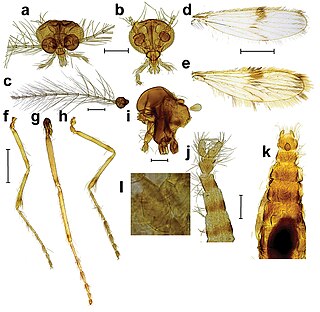
Kalophrynus is a genus of microhylid frogs. It is the only genus in the subfamily Kalophryninae. The species in this genus are found in southern China, in Southeast Asia to Java and Philippines, and in Assam, India.

Corethrella is a genus of midges that are classified in the family Corethrellidae.

Agrotera is a genus of snout moths in the subfamily Spilomelinae of the family Crambidae. It is the type genus of the tribe Agroterini and currently comprises 28 species distributed in the Afrotropical, Palearctic, Indomalayan and Australasian realm.

Paratalanta is a genus of moths of the family Crambidae. Synonym is Microstega.

Thliptoceras is a genus of moths of the family Crambidae. The genus was erected by William Warren in 1890.
Thliptoceras artatalis is a moth in the family Crambidae. It was described by Aristide Caradja in 1925. It is found in southern China in Zhejiang, Fujian, Jiangxi, Guangdong, Guangxi, Hainan and Guizhou.
Thliptoceras amamiale is a moth in the family Crambidae. It was described by Eugene G. Munroe and Akira Mutuura in 1968. It is found in Japan. Records for China refer to Thliptoceras sinensis.
Thliptoceras anthropophilum is a moth in the family Crambidae. It was described by Hans Bänziger in 1987. It is found in Thailand and Yunnan, China.
Thliptoceras bicuspidatum is a moth in the family Crambidae. It was described by Zhang in 2014. It is found in Guangdong, China.
Thliptoceras bisulciforme is a moth in the family Crambidae. It was described by Zhang in 2014. It is found in Guangxi, China.
Thliptoceras caradjai is a moth in the family Crambidae. It was described by Eugene G. Munroe and Akira Mutuura in 1968. It is found in China in Jiangsu, Zhejiang, Fujian, Jiangxi, Guangdong, Guangxi, Hainan and Guizhou.

Thliptoceras fenestratum is a moth in the family Crambidae. It was described by Per Olof Christopher Aurivillius in 1910. It is found in Tanzania.
Thliptoceras fimbriata is a moth in the family Crambidae. It was described by Charles Swinhoe in 1900. It is found in northern China.
Thliptoceras formosanum is a moth in the family Crambidae. It was described by Eugene G. Munroe and Akira Mutuura in 1968. It is found in China in Fujian, Jiangxi, Guangdong, Guangxi and Guizhou and in Taiwan.
Thliptoceras fulvimargo is a moth in the family Crambidae. It was described by William Warren in 1895. It is found in China (Guangxi), India and Myanmar.
Thliptoceras gladialis is a moth in the family Crambidae. It was described by John Henry Leech in 1889. It is found in China in Fujian, Guangdong and Yunnan and in Taiwan.
Thliptoceras impube is a moth in the family Crambidae. It was described by Zhang in 2014. It is found in Guangdong, China.
Thliptoceras semicirculare is a moth in the family Crambidae. It was described by Zhang in 2014. It is found in Guangdong, China.
Thliptoceras shafferi is a moth in the family Crambidae. It was described by Hans Bänziger in 1987. It is found in Guangdong and Guangxi in China and Chiang Mai in Thailand.
Thliptoceras sinensis is a moth in the family Crambidae. It was described by Aristide Caradja in 1925. It is found in China in Shanghai, Zhejiang, Fujian, Jiangxi, Guangdong, Guangxi, Hainan and Guizhou.




